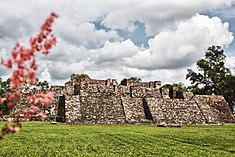
Back Ceremonia del Fuego Nuevo Spanish Cérémonie du feu nouveau French Upacara Api Baru ID Cerimonia del Fuoco Nuovo Italian Cerimónia do Fogo Novo Portuguese 新火典禮 Chinese
 |
| Aztec civilization |
|---|
| Aztec society |
| Aztec history |
The New Fire Ceremony (Spanish: Ceremonia del Fuego Nuevo) was an Aztec ceremony performed once every 52 years—a full cycle of the Aztec “calendar round”—in order to stave off the end of the world. The calendar round was the combination of the 260-day ritual calendar and the 365-day annual calendar. The New Fire Ceremony was part of the “Binding of the Years” tradition among the Aztecs.[1][2]
The Binding of the Years occurred every 52 years, or every 18,980 days as a part of the combination of the two calendars. Arithmetically, the duration of the Calendar Round is the least common multiple of 260 and 365; 18,980 is 73 × 260 Tzolkʼin days and 52 × 365 Haabʼ days derived from the Maya calendar. During this time the Aztecs believed the sun might not come back. The Aztecs wanted to symbolically and literally purify and "renew" their lives for the beginning of the new 52 year cycle. Therefore, many items such as hearth stones were thrown out in order to not be associated with the old cycle in any way. They used this time as a "spring cleaning" to honor the old and prepare for the new. It was the fire that acted as this Binding of the Years.[3][2]
The ceremony itself entailed all the fires being put out. Then, in Uixachtlan they started a fire on the chest of a captive and cut out his heart to place it in to fuel the fire. The fire then was taken all over the city to celebrate because the sun would return. People would cut their ears and put their blood in the fire. Thus the New Fire Ceremony started the new cycle and ensured the sun would return each day for another 18,980 days.[3][2]
The New Fire ceremonies were not limited to the Aztecs. In fact it was an ancient and widespread ritual in Postclassic Central Mexico that the Aztecs appropriated to their own society.[4][5] The Anales de Tlatelolco mention the Aztecs upon achieving independence of the Tepanec state celebrated a New Fire ceremony that marked the beginning of the calendric count of the Aztecs. This suggests that the ceremony was also used as a dynastic foundation rite.[5]
- ^ Smith, Michael E. (1997). The Aztecs. Blackwell. ISBN 1557864969. OCLC 59639052.
- ^ a b c Bernardino, de Sahagún (1953–82). Florentine Codex : general history of the things of New Spain. School of American Research. ISBN 087480082X. OCLC 59242829.
- ^ a b Von Winning, Hasso (1979). "The "Binding of the Years" and the "New Fire Ceremony" in Teotihuacan". Ibero-Amerikanisches Institut, Stiftung Preußischer Kulturbesitz.
- ^ Link text, https://www.cambridge.org/core/journals/ancient-mesoamerica/article/archaeological-deposits-from-the-aztec-new-fire-ceremony/F70E3D3ECBF50C2164866F8280BA3EA7
- ^ a b Elson, Christina M.; Smith, Michael E. (July 2001). "Archaeological Deposits from the Aztec New Fire Ceremony". Ancient Mesoamerica. 12 (2): 157–174. doi:10.1017/S0956536101122078. ISSN 0956-5361. S2CID 25246053.
© MMXXIII Rich X Search. We shall prevail. All rights reserved. Rich X Search